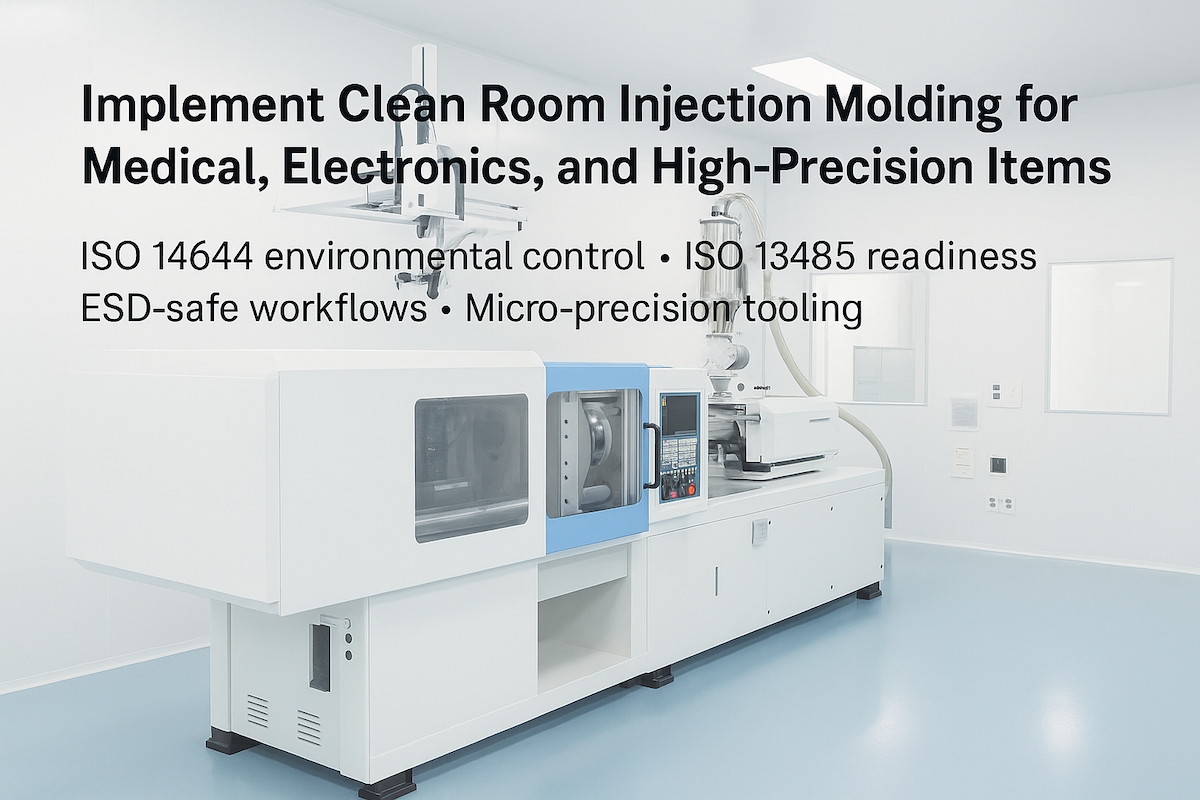Implement Clean Room Injection Molding for Medical, Electronics, and High-Precision Items
Implement Clean Room Injection Molding for Medical, Electronics, and High-Precision Items

Implement Clean Room Injection Molding for Medical, Electronics, and High-Precision Items
ISO 14644 environmental control • ISO 13485 readiness • ESD-safe workflows • Micro-precision tooling
When parts must be pristine—clinically clean, ESD-safe, and dimensionally tight—clean room injection molding turns risk into reliability. The TaiwanMoldMaker.com network combines controlled environments, validated processes, and audit-ready data to move your program from RFQ to SOP with confidence.
Explore our end-to-end services:
Custom Mold & Design Maker → Mold Service → Injection Mold → Molding → Customer Examples → Contact
What “clean room molding” means in practice
-
Controlled environment: ISO 14644-1 Class 7/8 (or better as required) with HEPA filtration, positive pressure, air changes per hour, and gowning SOPs.
-
Material hygiene: Dedicated dryers/hoppers, sealed conveyance, lot segregation, and purge validation to avoid gels/black specs.
-
Process discipline: Decoupled II molding with cavity-pressure sensors, mold-temperature control, and gate-freeze studies.
-
Traceability: MES dashboards for OEE, CpK, scrap, kWh/kg, and lot genealogy—shareable links for remote audits.
-
Inspection & metrology: FAIR + CMM/scan, visual acceptance standards, particle/bioburden or ionic tests where required.
Sector-specific requirements we support
Medical & Labware
-
Quality system: ISO 13485 alignment; design/process FMEA tied to CTQs.
-
Biocompatibility: Material strategy for ISO 10993 and sterilization (EtO, gamma, steam) where applicable.
-
Packaging: ISO 11607 validations for sterile barrier systems; clean-bagging and label control.
-
Materials: PP, COC/COP, PC, PPSU/PSU, PEI, TPE/TPU (medical grades).
Electronics & Opto
-
ESD control: ANSI/ESD program (wrist straps, floors, garments, ionizers), ESD-safe material options.
-
Cleanliness: Ionic contamination and FOD controls; low-outgassing resins for optics/sensors.
-
Materials: LCP, PBT/PET, PC-ABS, PA12/PA66, PC (optical), PMMA; antistatic/FR grades on request.
-
Packaging: Moisture barrier & desiccant for MSL parts; ESD shielding bags and labels.
High-Precision & Micro Features
-
Micro tooling: High-polish steel (S136/420SS), sub-inserts, and conformal-cooled cores for thermal stability.
-
Tolerances: GD&T on CTQs with capability targets (typ. CpK ≥ 1.33 unless otherwise specified).
-
Inline checks: Vision SPC for critical dimensions and cosmetic gates on every cycle.
DFM rules that keep parts clean and capable
-
Uniform walls (1.5–3.0 mm); replace mass with ribs to prevent sinks and long residence times.
-
Draft & radii: ≥1–2° draft (more on textured zones); generous radii to reduce particle generation at eject.
-
Gate strategy: Valve gates for vestige/cosmetics; edge/fan for commodity labware—always away from viewing/fluid paths.
-
Ejector plan: Push from bosses/pads outside critical or flow regions; avoid witness marks in optical or sealing areas.
-
Tool maintainability: Pull-plate access, standardized hardware, and serialized inserts with PM intervals by shots.
Automation that safeguards cleanliness
-
Robot take-out / closed transfer to trays or nests reduces touchpoints and fibers.
-
Inline functional tests (leak/occlusion/weld torque) and vision SPC minimize rework loops.
-
Sealed packing cells: clean-bagging, linered cartons, humidity control, and barcode genealogy.
Example timeline (pilot → validated production)
-
Day 0–2: 48-Hour DFM Pack (flow/cool/warp, gate & cycle model, risk log) → alignment call
-
Day 3–10: Tool build (Al/MUD or pre-hard steel) + EOAT/fixture design; cleanroom workflow plan
-
Day 11–13: T0 in production resin; weight ladder, gate freeze, cavity balance, preliminary metrology
-
Day 14–18: T1 + FAIR + CMM/scan; cleanliness/bioburden or ionic tests as required; DOE window locked
-
Day 19–30: PPAP (auto) or IQ/OQ/PQ (med/electronics) with alarms/lockouts on press and MES
-
Day 31+: PQ/ramp; copy-cavity proposal and packaging validation
(Steel-first or multi-cavity programs: typically ~20–28 days to T0 depending on geometry and finish.)
RFQ checklist (copy/paste—prevents rework)
-
Target T1/SOP dates and milestone gates (DFM, T0, T1, validation).
-
CAD (STEP/IGES) + 2D with CTQs/GD&T; cosmetic & viewing zone map.
-
Cleanroom level (molding/assembly/pack) and tests required (bioburden, particulates, ionic).
-
Material(s) & compliance (medical/food/FR/UV/ESD; sterilization method & cycles if any).
-
Tooling plan (MUD/Al/steel; cavitation; slides vs hand-loads; conformal-cooling candidates).
-
Automation & inline tests (EOAT, leak/weld/mark, vision SPC).
-
Validation scope (PPAP or IQ/OQ/PQ, DOE, CpK targets).
-
Data access (MES dashboards for OEE, CpK, scrap, kWh/kg, genealogy).
-
Packaging & logistics (clean bags, MSL/ESD, labels, FA courier, Incoterms).
Send your package here → Contact
Why choose the TaiwanMoldMaker.com network
-
Cleanroom-ready, robot-ready cells operated under documented SOPs and environmental monitoring.
-
Medical, electronics, and micro-precision experience with references on request.
-
Audit-ready documentation and live MES visibility so stakeholders approve fast.
-
Bridge-to-scale path: Start with aluminium/MUD pilots and copy-cavity steel when demand lands.
Start here:
Injection Mold → Molding → Mold Service → Customer Examples → Contact








